The Shock of the New: Chris Moriarty’s Spin State
 My reading’s defined, largely, by sheer chance. I stumble across something at a used-book sale, buy it along with a box of other books, put it on my shelf and forget about it, then finally years later take it down and read it and, often, realise I should have started in on it long before. Which is a long way around to explaining how I just now came to read Chris Moriarty’s debut novel Spin State, which was published in 2003. And why I’m only now writing about the best work of 21st-century science fiction I personally have read.
My reading’s defined, largely, by sheer chance. I stumble across something at a used-book sale, buy it along with a box of other books, put it on my shelf and forget about it, then finally years later take it down and read it and, often, realise I should have started in on it long before. Which is a long way around to explaining how I just now came to read Chris Moriarty’s debut novel Spin State, which was published in 2003. And why I’m only now writing about the best work of 21st-century science fiction I personally have read.
The first book of a trilogy (the second, Spin Control, came out in 2007; the third, Ghost Spin, was published earlier this year), Spin State was nominated for the Philip K. Dick Award and the Spectrum Award. A frenzied yet controlled mixture of hard sf, cyberpunk, space opera, political saga, hard-boiled noir, war story, and any number of other genres, Spin State captures the mind-shredding sense of wonder of science fiction as well as any book I’ve ever read. It’s densely written, intricately and dextrously plotted, and boasts dialogue both fiercely dramatic and bluntly true. It also always seems to aim at character, using its twists to generate powerful scene after powerful scene.
It ought to be a mess. It’s a long book, but covers much ground; it seems that every scene, every line, is doing three different things — touching off fuses to detonate later. But it never falls apart, never distintegrates into noise. It challenges you: I had to read the opening pages twice before I caught the rhythm of it. Set hundreds of years in the future, AIs possess wired human bodies, genetic constructs build interstellar Syndicates, and quantum technologies make distance something different than what we understand: you can physically be located on a space station in a far solar system but sit down to a full meal in an elegant restaurant on the Moon in the light of the environmentally ruined Earth. Technologies and politics are complex, and in fact the history of this future is complex all along the line: there’s a kind of take-no-prisoners ferocity to the unrelenting beat of new and wild ideas the book throws at you. Which is to say it’s in the best tradition of science fiction.
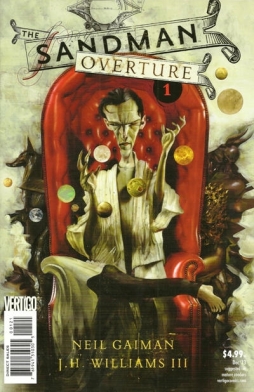 Late last October, the first issue of Sandman: Overture reached comic store shelves. The start of a new bimonthly six-part story, with art by J.H. Williams III, it’s a prologue to writer Neil Gaiman’s widely-acclaimed Sandman series, which ran for 75 issues (plus a special, some spin-off miniseries, a novella, and a collection of short comics stories) from 1988 to 1996. The series built in popularity as it went on and seems to have continued to find an audience in the years since its conclusion. It’s sustained a level of commercial appeal — perhaps as much as any single comic series, it helped to create the contemporary market for trade paperbacks — while also drawing critical praise, both inside and outside of comics. Issues or storylines of the main series were repeatedly nominated for the British Fantasy Awards, and once for the Stoker, while one issue won the 1991 World Fantasy Award.
Late last October, the first issue of Sandman: Overture reached comic store shelves. The start of a new bimonthly six-part story, with art by J.H. Williams III, it’s a prologue to writer Neil Gaiman’s widely-acclaimed Sandman series, which ran for 75 issues (plus a special, some spin-off miniseries, a novella, and a collection of short comics stories) from 1988 to 1996. The series built in popularity as it went on and seems to have continued to find an audience in the years since its conclusion. It’s sustained a level of commercial appeal — perhaps as much as any single comic series, it helped to create the contemporary market for trade paperbacks — while also drawing critical praise, both inside and outside of comics. Issues or storylines of the main series were repeatedly nominated for the British Fantasy Awards, and once for the Stoker, while one issue won the 1991 World Fantasy Award.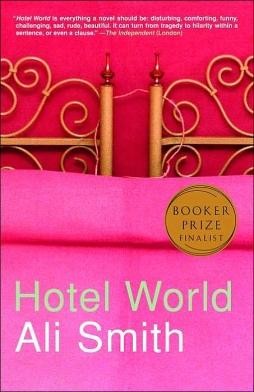
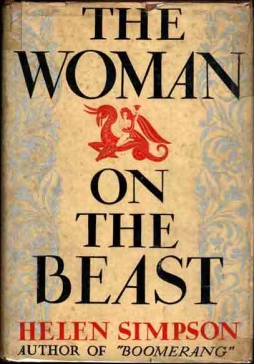 One of the distinct pleasures of used-book sales is finding an old book about which you know nothing, and making a cheap gamble: a literary bet that the story will prove worth the coin. You hope it pays off with unsuspected greatness, but for me as a reader the bet’s covered if I find something memorably strange. Not necessarily greatly strange, but eccentric, interesting, and outside the received narratives of literary histories (and genre histories past). Which brings me to Helen Simpson’s 1933 novel The Woman on the Beast: Seen From Three Angles.
One of the distinct pleasures of used-book sales is finding an old book about which you know nothing, and making a cheap gamble: a literary bet that the story will prove worth the coin. You hope it pays off with unsuspected greatness, but for me as a reader the bet’s covered if I find something memorably strange. Not necessarily greatly strange, but eccentric, interesting, and outside the received narratives of literary histories (and genre histories past). Which brings me to Helen Simpson’s 1933 novel The Woman on the Beast: Seen From Three Angles.
 This summer,
This summer, 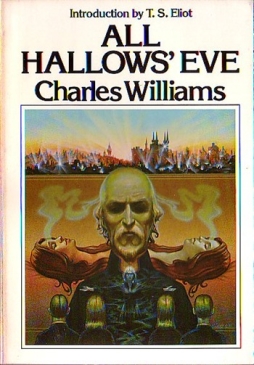 I observed the other day that the end of October’s a good time for reading classic weird fiction. This morning, as young ghosts and goblins of all sorts are preparing their evening’s depredations, I’m writing about a subject I’ve wanted to deal with for a while: the novels of Charles Williams. Williams was born in 1886, and died in 1945; a scholar, poet, editor, and theologian as well as a novelist, he’s probably the third-best-known of the informal group of Oxford Christians called the Inklings, behind C.S. Lewis and J.R.R. Tolkien. A Christian fascinated with the occult, his novels are tales of the supernatural and the numinous at play in the ‘real’ world. He wrote of ghosts, magi, and the Holy Grail, among other things, and his stories, laboured and profound, are some of the strangest fantasies I know.
I observed the other day that the end of October’s a good time for reading classic weird fiction. This morning, as young ghosts and goblins of all sorts are preparing their evening’s depredations, I’m writing about a subject I’ve wanted to deal with for a while: the novels of Charles Williams. Williams was born in 1886, and died in 1945; a scholar, poet, editor, and theologian as well as a novelist, he’s probably the third-best-known of the informal group of Oxford Christians called the Inklings, behind C.S. Lewis and J.R.R. Tolkien. A Christian fascinated with the occult, his novels are tales of the supernatural and the numinous at play in the ‘real’ world. He wrote of ghosts, magi, and the Holy Grail, among other things, and his stories, laboured and profound, are some of the strangest fantasies I know.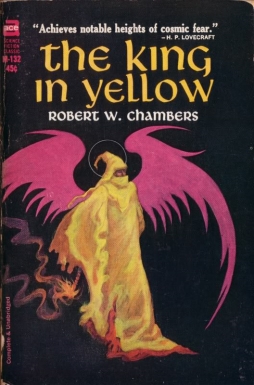 October draws to a close and so it’s time to turn to horror and the supernatural, to the weird tale and the things that cannot be known. Today, I want to look at one of the founding classics of the weird, Robert W. Chambers’s collection of linked short stories, The King in Yellow. Published in 1895, it was celebrated by H.P. Lovecraft, who used some of the book’s ideas in his Cthulhu mythos; in fact, the book’s inspired a mythos of its own, complete with
October draws to a close and so it’s time to turn to horror and the supernatural, to the weird tale and the things that cannot be known. Today, I want to look at one of the founding classics of the weird, Robert W. Chambers’s collection of linked short stories, The King in Yellow. Published in 1895, it was celebrated by H.P. Lovecraft, who used some of the book’s ideas in his Cthulhu mythos; in fact, the book’s inspired a mythos of its own, complete with  A little while ago,
A little while ago, 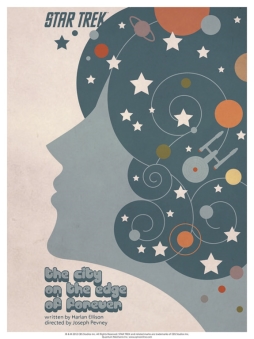 This is the second part of my attempt to write about Star Trek, and specifically the episode “The City on the Edge of Forever.” For reasons which I hope will soon make sense
This is the second part of my attempt to write about Star Trek, and specifically the episode “The City on the Edge of Forever.” For reasons which I hope will soon make sense